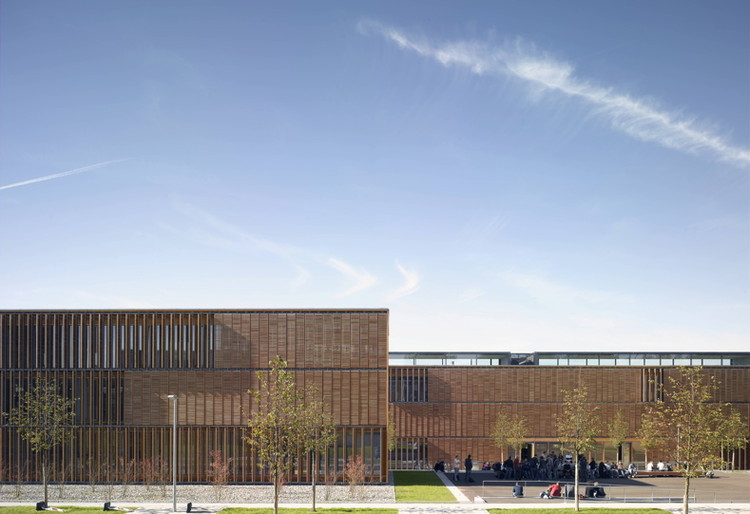
Text description provided by the architects. Landscape and architecture
Three buildings, covered with wood, are situated on a gentle slope with a beautiful view in Aalen. Originally the site was an enlargement area of the existing university of applied sciences, a building designed of Günther Behnisch in 1969. There was an existing urban masterplan with a linear arrangement of the buildings and a central pedestrian zone. Trees planted along the streets integrate the buildings in the nature. A square surrounded by the library and the different faculties provide an open-air space for recreation after exhausting lectures. The now realised buildings are the first steps of a small hopeful growing village, a campus of research and education.

Touching the ground
Precise shaped objects arranged on linear terraces divided by low walls. The buildings are fixed on the angle of the walls. Ramps are connecting the different levels of the terraces. Pathways and squares form an urban system built with concrete, asphalt and gravel. A light and transparent texture of wooden slats enclose the massive body of the houses. The precise structure creates a new relationship with the seasonal changing trees along the streets. This emphasises the relationship between nature and building.

Organization
The layout of the buildings are organized into three functional layers. On the east side you can find the offices and functional spaces and on the west side the seminar rooms and laboratories. The lecture rooms and large exercise rooms form the front end of the buildings. Light courts and staircases alternate in the corridor zone.

Precise shapes
The clearly compositions attract attention to the facades who are textured with numerous vertical lines. Made in larch, the wooden shutters create a deep, changing surface; a game between visual transparency und closeness. It takes 90 seconds to open the shutters and the transparent facade appears. Depending on the position of the louvers the building look like a box of wood or a glass object. 2420 revolving shutters cover about 4500 sqm of the main facades. Due to the modular grid of 60 cm the design enables a flexible partitioning of rooms.

The supporting structure of the three story buildings is caste-in-place concrete. The traces of the castings show how the building was erected. Inside the building this skeleton is sophisticated in the finishing details and elements. The public areas are covered with blue grey shell limestone from the area. The colour is very similar to concrete. The not-supporting walls are made out of gypsum carton and painted white.

Technique
Basically the main facade is split into three levels of function. The room-high glass facade covers the long sides of the buildings. Prefabricated wooden post-and-rail construction with a modular grid of 60 cm includes double glazing which provides the thermal isolation. The ventilated cavity between the glass facade and the wooden sunscreen is used as service space. On the galvanised steel substructure the wooden shutters are fixated. Because of its self-supporting system only the horizontal forces are lead to the concrete construction. The rotating shutters are individually mechanical operated.

Special Spaces
Because of the beautiful view to the city of Aalen the library was expanded with a outdoor reading room, the balcony. A quiet relaxed space for reading, thinking or to take the air.
Inside the faculty building the massive concrete core creates a very intimate atmosphere. The long internal corridors are interrupted by three story high voids. So the interior space support the strong contrast to the outside of the building. The empty voids are covered with glass. Walking down the central staircases, a sequence of windows frame the view to the landscape. Untreated concrete and natural stone form a strong and massive impression in the busy heard of the buildings.
Precision in form and technique create a new building like pieces of wooden furniture on the new campus.
























